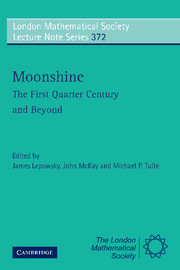 Moonshine - The First Quarter Century and Beyond
Moonshine - The First Quarter Century and Beyond Book contents
- Frontmatter
- Contents
- Preface
- Schedule of Talks
- Characters of Crossed Modules and Premodular Categories
- On the Injectivity of the Kudla-Millson Lift and Surjectivity of the Borcherds Lift
- Ordered Spanning Sets for Vertex Operator Algebras and their Modules
- Friendly Giant Meets Pointlike Instantons? On a New Conjecture by John McKay
- Modularity of Trace Functions in Orbifold Theory for ℤ-Graded Vertex Operator Superalgebras
- Twisted Modules for Vertex Operator Algebras
- Vertex Operators and Sporadic Groups
- The Algebraic Meaning of Being a Hauptmodul
- Borcherds' Proof of the Conway-Norton Conjecture
- On the Connection of Certain Lie Algebras with Vertex Algebras
- Vertex Operators and Arithmetic: How a Single Photon Illuminates Number Theory
- Rational Vertex Operator Algebras and their Orbifolds
- Quasi-finite Algebras Graded by Hamiltonian and Vertex Operator Algebras
- On Certain Automorphic Forms Associated to Rational Vertex Operator Algebras
- Moonshine and Group Cohomology
- Monstrous and Generalized Moonshine and Permutation Orbifolds
- New computations in the Monster
Vertex Operators and Arithmetic: How a Single Photon Illuminates Number Theory
Published online by Cambridge University Press: 06 July 2010
- Frontmatter
- Contents
- Preface
- Schedule of Talks
- Characters of Crossed Modules and Premodular Categories
- On the Injectivity of the Kudla-Millson Lift and Surjectivity of the Borcherds Lift
- Ordered Spanning Sets for Vertex Operator Algebras and their Modules
- Friendly Giant Meets Pointlike Instantons? On a New Conjecture by John McKay
- Modularity of Trace Functions in Orbifold Theory for ℤ-Graded Vertex Operator Superalgebras
- Twisted Modules for Vertex Operator Algebras
- Vertex Operators and Sporadic Groups
- The Algebraic Meaning of Being a Hauptmodul
- Borcherds' Proof of the Conway-Norton Conjecture
- On the Connection of Certain Lie Algebras with Vertex Algebras
- Vertex Operators and Arithmetic: How a Single Photon Illuminates Number Theory
- Rational Vertex Operator Algebras and their Orbifolds
- Quasi-finite Algebras Graded by Hamiltonian and Vertex Operator Algebras
- On Certain Automorphic Forms Associated to Rational Vertex Operator Algebras
- Moonshine and Group Cohomology
- Monstrous and Generalized Moonshine and Permutation Orbifolds
- New computations in the Monster
Summary
Introduction
This paper is based on a talk I gave at the Spitalfields Day, held under the auspices of the London Mathematical Society during the Edinburgh Conference on Moonshine. As such, it is intended for nonspecialists.
Consider the following confluence of ideas:
As closed strings move in space-time they sweep out a worldsheet which carries the structure of a Riemann surface.
Riemann surfaces occur as quotients Г \ H of the complex upper half-plane H by arithmetic groups Г ⊆ SL(2,R).
The modular forms associated to Г \ H carry arithmetic information manifested in the coefficients of the corresponding Fourier series.
Vertex operator algebra theory may be construed as an algebraicization of aspects of the theory of elementary particles (bosonic strings) and their interactions.
Monstrous Moonshine relates certain distinguished elliptic modular functions (so-called hauptmoduln) to the Monster simple group M.
M is the automorphism group of a particular vertex operator algebra, the Moonshine Module V♭, which models bosons in the critical dimension c = 24 as a Z2-orbifold.
The reader who is not conversant with all of these ideas should have no fear. The statements above are intended only as background, and to suggest several points. The first is the inevitability of connections between elliptic modular forms, vertex operator algebras and finite groups; the second is the intimate connection with ideas from theoretical physics (string theory and conformal field theory).
- Type
- Chapter
- Information
- Moonshine - The First Quarter Century and BeyondProceedings of a Workshop on the Moonshine Conjectures and Vertex Algebras, pp. 255 - 269Publisher: Cambridge University PressPrint publication year: 2010


